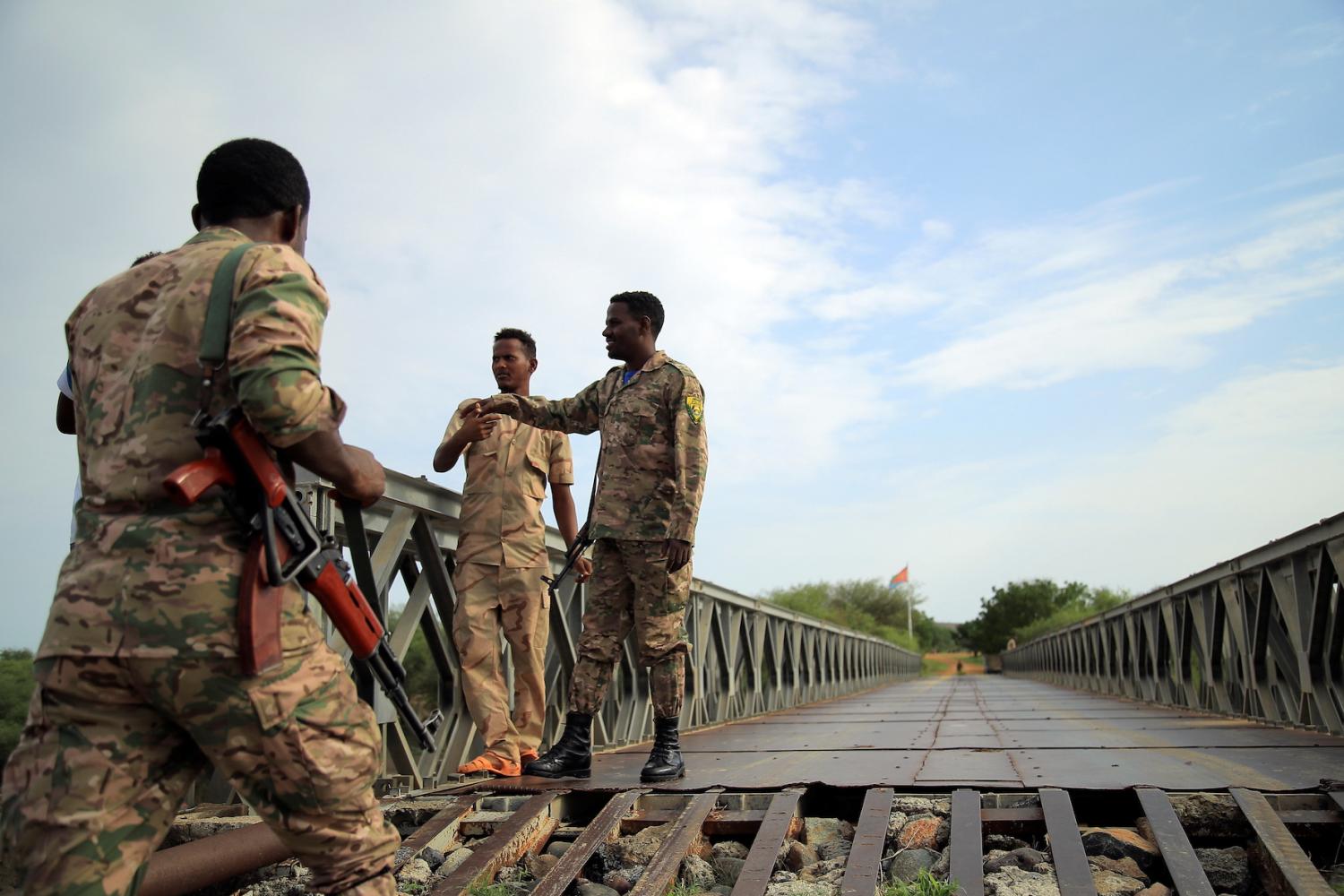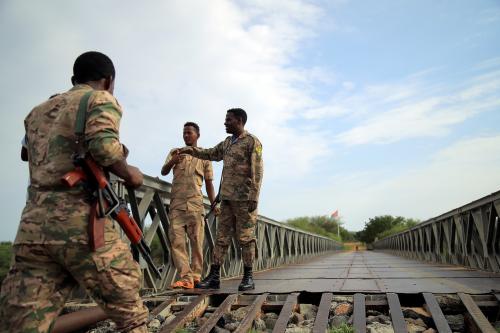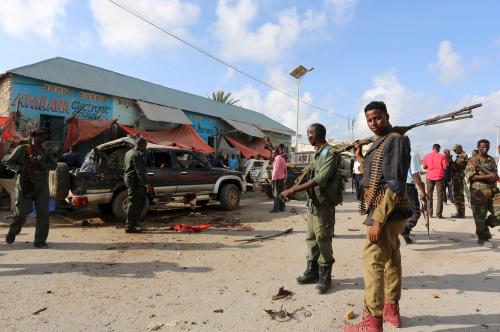This piece is part of a series titled “Nonstate armed actors and illicit economies in 2024” from Brookings’s Initiative on Nonstate Armed Actors.
Instability generated by nonstate armed actors and threats posed by illegal economies will grow in 2024, jeopardizing a wide range of U.S. interests as regional and global powers look to exploit them. Will Washington find a way to rebalance its preoccupation with great power competition by mounting an effective response toward nonstate armed actors and appropriately engaging in other countries’ important internal issues? An effective response requires a U.S. policy that does not neglect or distort internal developments as essentially driven by Russia and China’s machinations.
2023 dramatically showed how U.S. foreign policy had moved beyond the post-9/11 era and its focus on internal security developments and stabilization. Washington’s overwhelming prioritization of countering China and Russia translated into great power competition dominating the U.S. agenda around the world, including in Africa and Latin America, even as a myriad of nonstate armed actor threats escalated.
Pulling back from dealing with internal issues also characterized U.S. policy in the Middle East — until Hamas’s vicious terrorist attack on Israel in October. The subsequent escalation of violent activities by the Houthis in Yemen and the Red Sea, Hezbollah in Lebanon, and pro-Iran militias in Iraq, and the risk of a regional war, at least temporarily thrust regional nonstate armed actors back to the forefront of U.S. policy.
This commentary maps out nonstate armed actor threats in the Middle East and Africa. A companion commentary maps these issues in Asia, the Americas, and Europe as well as in functional domains such as drug and wildlife trafficking, technology, and crime.
The Middle East
Regardless of whether Israel smashes Hamas or stimulates the emergence of other violent groups, nonstate armed actors across the Middle East were given a fillip by Hamas’ attack and Israel’s response against Gaza, which has killed more than 20,000 Palestinians. Militias supported by Iran, forming Iran’s Axis of Resistance against the United States and Israel, have especially benefited from these events.
To a varied extent, the Houthis in Yemen, Hezbollah in Lebanon, and pro-Iran militias in Iraq have come to play a governing role in their countries. The Houthis represent the aspirations of a minority, and Hezbollah effectively delivers a narrow range of services to its sectarian constituency. Pro-Iran militias in Iraq have not only subverted the country’s institutions but also formalized their power. Yet all of these actors have proven deeply problematic in national-level governance. Their governance remains parochial, sectarian, self-serving, and corrupt as they struggle to address their respective countries’ massive social and economic problems.
With Iran’s prodding, the war in Gaza gives these nonstate and hybrid actors a tool to divert public attention in their countries from their governance deficiencies and spoiler activities. Instead of local publics being able to demand greater accountability from these actors, they are redirected to the suffering in Gaza and the militias’ violent “resistance” — piracy attacks on ships in the Red Sea, the shelling of Israel, and missile attacks on U.S. military installations.
Nonstate armed actors in the Middle East will continue exploiting this Gaza recipe during 2024. Unless Washington becomes willing to reengage deeply in the region’s internal politics (with now diminished tools), the Axis of Resistance militias will increase their power and impunity, with a crust of misgovernance solidifying over these countries. In a particularly bad scenario, the pro-Iran militias in Iraq could finally expel the U.S. military from Iraq, with a wide set of resulting negative repercussions, including a significant decrease in U.S. intelligence assets in the Middle East, a grave reduction in the U.S. ability to support its special operations forces in Syria, a significant augmentation of Iran’s power over Iraq, and a deterioration of Kurdistan’s self-governance.
Meanwhile, the Islamic State (IS) threat in the Middle East will continue simmering, not simply because of the occasional attack by its Afghanistan affiliate, but more fundamentally because of the continually unaddressed issue of IS detainees, including tens of thousands of women and children, in Syrian camps. The catastrophic humanitarian conditions and the rule of IS doctrine in the camps sentence many of the children to life-long detention, unless they can be repatriated and rehabilitated, and create a dangerous breeding ground for renewed terrorist activity.
Africa
Africa’s two arcs of crises — in the east and the west — will likely see flare-ups of violence in 2024.
Somalia’s military momentum against al-Shabab dissipated in the middle of 2023 and will unlikely be resurrected in 2024. At best, military action by both the Somali government and al-Shabab will plod at the current tempo, with the planned withdrawal of the international African Union Transition Mission in Somalia forces once again delayed. At worst, al-Shabab will intensify its terrorist attacks and perhaps retake some territory. Despite assistance from the United Arab Emirates, the Somali government still lacks the ability to address the perennial issues that have undermined all the country’s anti-jihadi campaigns: the need for adequate holding forces, effective engagement with clans, and the ability to deliver acceptable governance to territories that have flipped away from al-Shabab. Somalia’s other recurrent crucible — center-state relations — will likely further worsen in 2024 and draw attention away from the battle against al-Shabab.
In the coming months, Ethiopia could explode into significant violence again. The Amhara, Oromo, and other regional rebellions within Ethiopia can easily escalate in 2024, even if the decimated and militarily-spent Tigray region refrains from militancy and the levels of violence result in far fewer casualties than the several hundred thousand dead in the Tigray war.
Prime Minister Abiy Ahmed’s ambition to secure access to the Red Sea could provoke interstate clashes with Somalia, perhaps augmented by Eritrea’s machinations, while separate tensions with Sudan are growing. Additionally, even if Sudan’s devasting civil war quiets down or results in a cease-fire or a negotiated deal in 2024, its spillovers, also in the form of nonstate armed groups, will continue to destabilize the Horn of Africa.
Even while Mozambique and southern Tanzania remain quiescent, militants there have not been disarmed. The root causes of jihadi militancy in both countries remain unaddressed, while the Rwandan and Southern African Development Community forces in Mozambique lack an exit strategy, reflecting both the insufficient capacity of the Mozambiquan government and Rwandan economic and political interests.
Jihadi militancy in West Africa intensified gravely in 2023, and this negative trend remains undiminished this year. In Mali, both IS, its allies, and groups aligned with al-Qaida could establish their own proto-state. For months, the cities of Gao, Timbuktu, and Menaka have teetered on the brink of falling into jihadi hands. Militancy also dangerously intensified in Burkina Faso and is spilling over into northern Togo and Benin.
Outside of the Central African Republic, the Wagner Group, a Russian proxy, has been ineffective and even outright counterproductive in suppressing jihadi militancy in West Africa. But, despite the decapitation of its leadership by Moscow in August 2023, it continues to serve as a praetorian guard of national juntas and ruling actors — for example, suppressing a Tuareg rebellion in Mali — and thus retains sway. Since the demise of Wagner’s leadership, the Russian government has subordinated Wagner under the command of the Russian intelligence services and Ministry of Defense without a dramatic diminishment of Wagner’s presence across the Middle East and Africa. This has occurred even as Russia has moved to sign new agreements, such as with Niger, through the Ministry of Defense, instead of Wagner.
What to watch in 2024 is whether the Wagner Group will maintain its glitz and a veneer of effectiveness or whether African governments will hedge against its under-delivery of effective counterinsurgency, especially as Rwanda actively promotes the deployment of its forces in “stabilization” efforts across the continent. Although Rwanda’s president, Paul Kagame, has defended Russia’s military engagements in Africa in 2023, will Rwanda’s stabilization assistance start displacing and irritating the Russians?
Coups d’état in West Africa have played into Wagner and Russia’s hands, pushing the United States out of key counterterrorism bases, as the United States is legally constrained from engaging with putschists. Yet the United States’ favored response — economic sanctions — has proven insufficient to reverse the coups. With a potential for coups d’état spreading to the Great Lakes region and Africa’s east in 2024, will the United States thus develop a greater focus on and capacity for preventing coups? And will Washington retain an adequate emphasis on Wagner, or will it revert to neglecting Wagner’s nefarious activities in Africa as Wagner’s prominence in Ukraine continues to diminish in 2024?
Intense U.S. pressure has prevented the Democratic Republic of the Congo (DRC) from hiring the Wagner Group to quell the highly intensified violence across the country, particularly the M23 militancy. Instead, Bulgarian, Romanian, French, and other private military contractors have flocked into the DRC. With DRC President Félix Tshisekedi blaming Rwanda for fueling the M23 insurgency, raising the specter of a regional war, and criticizing the inability of the drawing-down United Nations stabilization mission to suppress M23, the SADC is now also deploying to the DRC. Apart from the lack of clarity as to its mandate and capabilities, the SADC mission could come into the crosshairs of Rwanda’s nefarious policy, with repercussions for Mozambique and beyond.
Overall, Africa will see some of the most intense nonstate armed actor violence in 2024. Yet, violence and illicit economies in the Americas will pose far more direct and immediate threats to the United States, as detailed in the next commentary.
The Brookings Institution is committed to quality, independence, and impact.
We are supported by a diverse array of funders. In line with our values and policies, each Brookings publication represents the sole views of its author(s).







Commentary
Nonstate armed actors in 2024: The Middle East and Africa
January 16, 2024